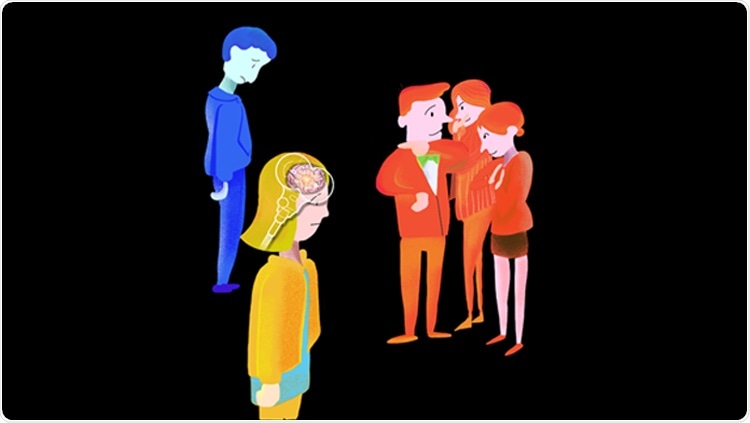A new study demonstrates that targeted brain stimulation is effective at dulling social pain. The results of the study highlight the potential use of brain stimulation alongside cognitive and behavioral strategies for treating a range of psychological disorders associated with emotion regulation problems.

Targeted brain stimulation dulls social pain. Image Credit: Zhao et al., JNeurosci 2020/Shutterstock.com
Potential to use brain stimulation to treat mental health problems
In a paper published this month in JNeurosci., researchers describe how pairing brain stimulation with strategies to manage emotion resulted in the blunting of negative emotions. The team were also able to show that stimulating key areas of the cortex without the pairing of emotion management techniques was enough to produce this effect on its own, although, to a lesser degree. The results of the study will likely influence the development of new, effective therapies to treat a broad range of psychiatric disorders.
Emotion regulation in psychiatric disorders
For many years research has been mounting, supporting the role of emotion regulation in a broad scope of psychological disorders, such as anxiety, bipolar disorder, borderline personality disorder, eating disorders, depression, somatoform disorders, and many more. Previous studies have linked deficits in emotion regulation in all of these disorders. Additionally, research has shown that poor emotion regulation is a risk factor of some disorders, with it predicting relapse in major depressive disorder.
It is clear that emotion regulation is vital to supporting other cognitive functions. Without proper emotion management, managing challenging and complex situations becomes difficult. It is easy to see the connection between emotion regulation and psychological problems.
To further explore this link, researchers designed a study that aimed to test whether activating areas of the brain known to be responsible for emotion regulation could impact the strength of the emotional response. In addition, they aimed to see that if pairing stimulation with emotion management techniques could enhance this effect.
Previous evidence has demonstrated that the human brain regulates emotion via two areas of the prefrontal cortex, the dorsolateral (DLPFC) and ventrolateral prefrontal cortex (VLPFC). The DLPFC is responsible for shifting attention, whereas the VLPFC reinterprets the situation. Researchers of the current study hypothesized that leveraging the independent roles of these two areas may present the opportunity of a novel treatment for managing the emotional symptoms of psychological disorders.
Transcranial magnetic stimulation (TMS) was used to enhance the activity of targeted areas of the cortex while participants viewed images of social pain. Participants were asked to rate their negative responses after viewing the image, after completing a distraction technique, or after reinterpreting the image in a positive light.
The study’s results showed that stimulation of either the DLPFC or the VLPFC was effective at decreasing the intensity of negative emotion felt after viewing the images of social pain. This effect lasted as long as an hour after brain stimulation had been delivered. In addition, the results showed that coupling the distraction strategy alongside DLPFC stimulation and pairing the reappraisal strategy with VLPFC stimulation decreased reported negative emotions further.
The study’s results demonstrate the potential therapeutic effect of combining targeted brain stimulation with appropriate regulation strategies.
TMS as a therapeutic option
Currently, a version of TMS, known as rTMS, is already being used as a therapy to treat major depression in patients who do not respond well to medication. It is possible that our use of brain stimulation as a therapeutic intervention for psychiatric disorders is just at the beginning.
As the results of the current study suggest, TMS can effectively help to regulate emotions, something that has been reported to be dysfunctional in a wide range of psychological disorders. Therefore, there is scope for using TMS as an alternative treatment for any disorder that is impacted by poor emotion regulation.